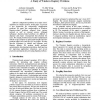Free Online Productivity Tools
i2Speak
i2Symbol
i2OCR
iTex2Img
iWeb2Print
iWeb2Shot
i2Type
iPdf2Split
iPdf2Merge
i2Bopomofo
i2Arabic
i2Style
i2Image
i2PDF
iLatex2Rtf
Sci2ools
DSN
2004
IEEE
2004
IEEE
Why PCs Are Fragile and What We Can Do About It: A Study of Windows Registry Problems
Software configuration problems are a major source of failures in computer systems. In this paper, we present a new framework for categorizing configuration problems. We apply this categorization to Windows Registry-related problems obtained from various internal as well as external sources. Although infrequent, Registry-related problems are difficult to diagnose and repair. Consequently they frustrate the users. We classify problems based on their manifestation and the scope of impact to gain useful insights into how problems affect users and why PCs are fragile. We then describe techniques to identify and eliminate such Registry failures. We propose health predicate monitoring for detecting known problems, fault injection for improving application robustness, and access protection mechanisms for preventing fragility problems.
| Added | 20 Aug 2010 |
| Updated | 20 Aug 2010 |
| Type | Conference |
| Year | 2004 |
| Where | DSN |
| Authors | Archana Ganapathi, Yi-Min Wang, Ni Lao, Ji-Rong Wen |
Comments (0)

